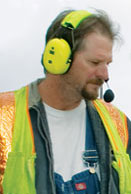Construction cranes are dangerous machines, but the people supervising, operating, erecting, dismantling and signaling them can be just as treacherous. The accident record proves it. Just about every week in the U.S., somebody dies from a crane accident. Nearly half of those fatalities are construction workers, and civilians are just as much at risk. Poor communication is at the heart of the problem.
 |
One of the reasons for vocal hangups among crane personnel is the lack of standards addressing communication around these machines. Until recently, industry standards offered little or no guidance on how spotters should give directions to crane operators over a radio, or how personnel should plan lifts. Federal regulations also are silent on radio language but they are expected to address elements by the decade’s end. The sooner, the better.
There still are too many unqualified operators running cranes. But the ones who do work safely are frustrated with riggers and signalers putting them in risky places. One of those hands is Jeff York, who sat in the seat for more than 20 years before he opened San Leandro, Calif.-based Signal-Rite LLC. Whether or not his proposed signal system becomes universally accepted, Signal-Rite is an innovative and fresh concept in safety.
 |
Just as airline pilots have radio protocols to make air travel safer, so must project teams have a common way of communicating when cranes take materials to the sky. Everyone should meet a single standard.
Hand signals have been standardized for more than 30 years, and they work well in many simple rigging situations. But cranes are getting bigger, loads are heavier and projects are pushing to new extremes. New radio technology makes communicating with cranes easier, more convenient and precise. But that precision must be honed by developing common radio signals to remove guesswork and speed hand, eye and ear coordination. Many cranes in the U.S. display hand signals on decals. It is time that manufacturers also remind project teams that voice signals can help them safely direct a heavy load suspended hundreds of feet in the air.
A lack of understanding about jobsite responsibility around cranes also contributes to accidents. Complacency leads to process failures, and people get hurt. In many states, operators are held to national testing guidelines, but unqualified personnel can work under the hook. Riggers and craft signalers also must be tested before they even walk on the job. At the very least, project teams should discuss protocol before work begins.
All crane accidents are unacceptable in an industry that prides itself on safety, professionalism and craftsmanship. Despite reform efforts, the death toll keeps climbing. Crane safety doesn’t start and stop with operators. Others need to be on the hook, too. Standard signals put everyone in closer contact.

Post a comment to this article
Report Abusive Comment